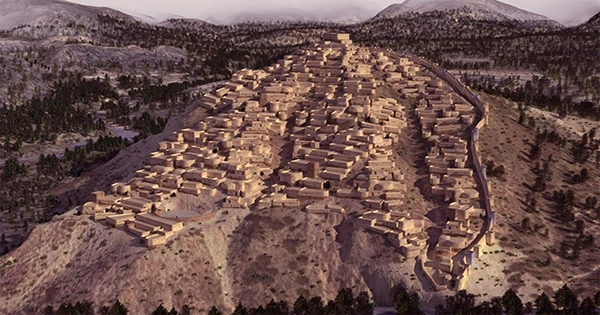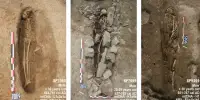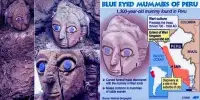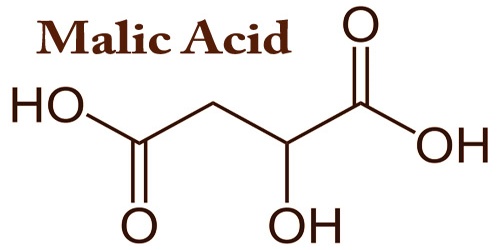Archaeologists and other scientists from numerous Spanish institutions have discovered a stunning fact about the Iron Age site of Casas del Turuuelo, which is located in southern Spain near the Mediterranean coast. The Tartessos culture, an enigmatic early Iron Age civilization that thrived in the region until about 2,500 years ago, appears to have used this ancient location regularly to execute animal sacrifice ceremonies.
While it has long been known that people in Europe in the first millennium BC performed large-scale animal sacrifice, it is rather rare to locate Iron Age sites that show proof of this.
Animal Sacrifice Findings at Casas del Turuuelo: A team of researchers led by archaeologist Maria Pilar Iborra Eres from the Valencian Institute of Conservation and Restoration (IVC+R) investigated animal remains discovered buried inside a destroyed edifice at Casas del Turuuelo.
This structure was deliberately demolished before being buried behind a 20-foot (six-meter) burial mound in the fifth century BC. The shattered edifice and entombment of its contents indicate that the Tartessian people understood they would not be using this location again. In reality, the date of its burial coincided with the extinction of the region’s whole culture.
Excavations beneath the mound revealed the remains of 52 sacrificed animals, including horses, cattle, pigs, and a single dog. The majority of these animal sacrifices were made up of adult horses. The site yielded around 6,770 individual bones in total. The researchers were able to draw some assumptions about how the animal sacrifices were performed based on the arrangement of the animal bones.
Was Ritual Feasting Similar to Animal Sacrifice?
Researchers discovered, for example, that the animal sacrifices were carried out in three distinct mass stages. The animals in the first two were simply slain before being buried, as evidenced by the fact that their skeletons were mostly intact. Skeletons connected with the third phase, on the other hand, displayed unambiguous signs of being processed, indicating that their meat was removed before they were buried. This suggests that the final major animal sacrifice was coupled with some kind of ritual supper.
“This study thus sheds light on both the sequence of the animal sacrifices and the protocols linked to rites accompanied by the celebration of banquets,” the study authors said in a paper published in the journal PLOS ONE about their findings. “This study thus advances notions serving to contextualize ritual animal sacrifices in the framework of practice observed at other Iron Age sites in the Iberian Peninsula and elsewhere throughout Europe.”
The sacrifice place must have been used several times over a long period, according to Spanish experts. Many ritual mass sacrifices may have taken place there. The animal bones were removed in some cases and buried or otherwise disposed of elsewhere.
Speculation Regarding the Role of Animal Sacrifice in Tartessian Culture: The Tartessians’ activities at Casas del Turuuelo, according to archaeologists, were distinctive for two reasons. On the one hand, they appear to have taken great care to ensure that only adult creatures were sacrificed (may these have been older animals that were sick or approaching death in the first place?). On the other hand, they sacrificed so many horses, which other Iron Age societies did not do.
Because horses were likely used for transportation and work in Tartessos culture, perhaps these animals were slaughtered so they could join their deceased owners in the hereafter, where their presence would probably be appreciated.
Such ideas are highly speculative. However, since the issue is the enigmatic Tartessos culture’s beliefs and behaviors, speculation is required. Little is known about who they were or what they believed, allowing archaeologists and historians to speculate on the true significance of any discovery associated with these long-lost Iron Age people.
Investigating the Mysterious Tartessos Culture: From the ninth to the early fifth centuries BC, the Tartessos culture dominated the Iberian Peninsula in what is now southwestern Spain. According to a succession of archeological findings, the society appears to have constructed its economy around the availability of rich metals such as gold, copper, and tin. As a result, they became an important trading partner for the Phoenicians, who resided along the eastern Mediterranean’s beaches.
The Tartessians were excellent shipbuilders as well as metallurgists, allowing them to develop long-distance trading links throughout the Mediterranean. The Tartessians were the first Iberian culture to have contact with earlier societies in northern Africa, the Middle East, and southern Europe, and these encounters may have impacted their philosophical and theological views to some extent.
By the fifth century BC, the Tartessians had virtually perished. Excavations at Tartessian sites have yielded no indication that they were invaded or captured by military action, hence the causes for their disappearance remain unknown. In every way, their existence in the archeological record is enigmatic. This helps to explain why any discovery that gives information on their cultural traditions, such as this recent animal sacrifice discovery, can be considered noteworthy.
















